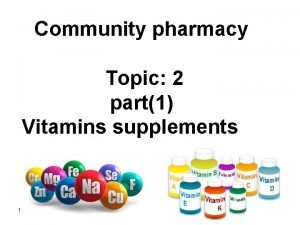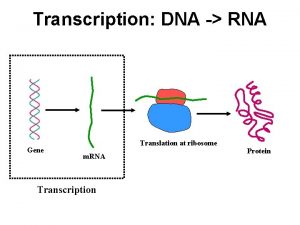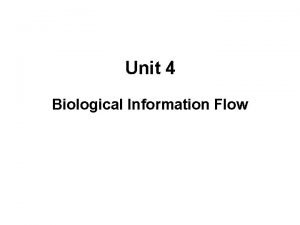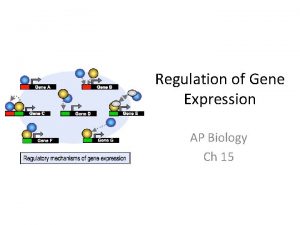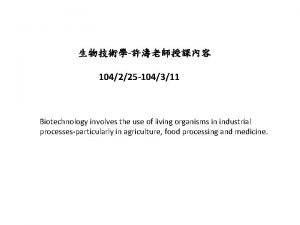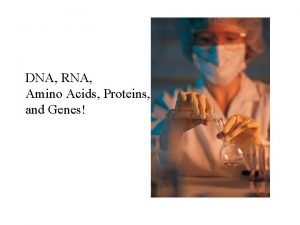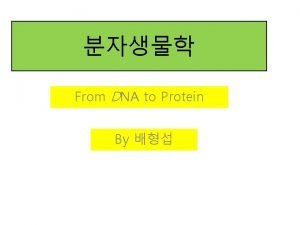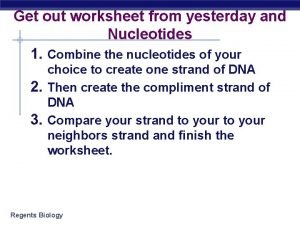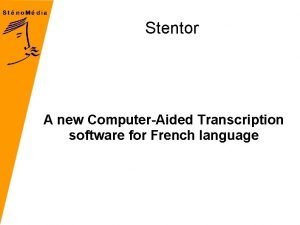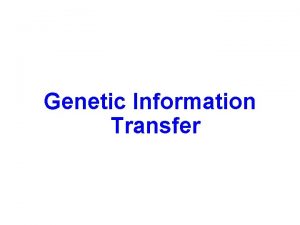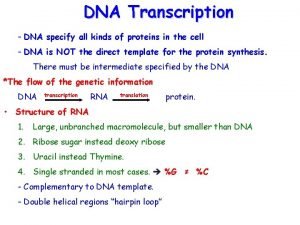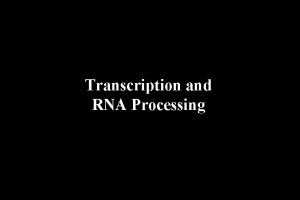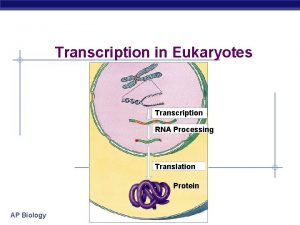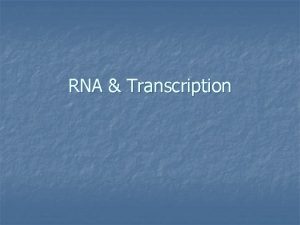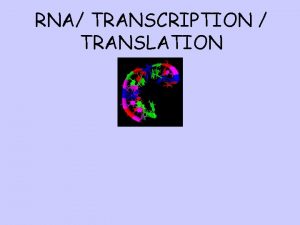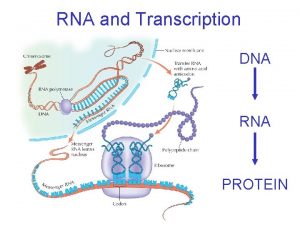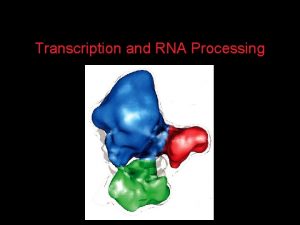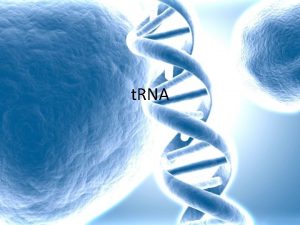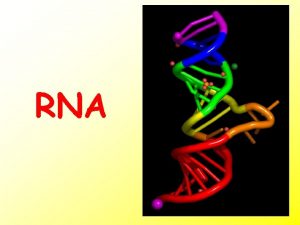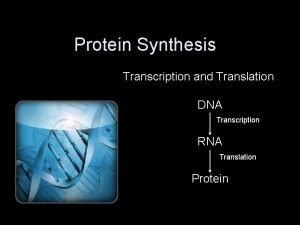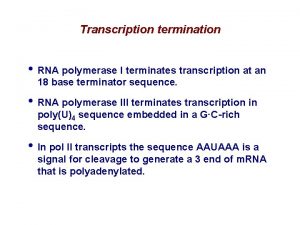RNA PROCESSING Part1 m RNA processing Transcription m

















- Slides: 17

RNA PROCESSING Part-1

m. RNA processing Transcription m 7 G DNA hn. RNP pre-m. RNA + specific proteins Capping pre-m. RNA Splicing m 7 G Cleavage + Polyadenylation (A)n Mature m. RNA Nucleus Translation Cytoplasm m 7 G Protein 2

m. RNA Capping

RNA processing step 1: Capping 1. As soon as RNA pol has made 25 nt nascent RNA a 5’-cap is put on the m. RNA. 2. Capping enzymes bind to the RNA polymerase tail (C terminal domain) and are ready to cap the RNA as it is made. 4

Reverse polarity 5’-5’ bond 5

Functions of the m. RNA cap 1. Facilitates splicing, 3’-endcleavage, polyadenylation, and perhaps nuclear export. Cap needed for the first intron to be spliced. 2. The cap (together with the poly(A) tail) is vital for m. RNA stability. Decapping is a key step in m. RNA turnover. 6

Functions of the m. RNA cap 3. The cap enhances translation by binding to e. IF 4 E and with the aid of the poly(A) tail provides scaffolding to directly bind and load the 40 S ribosome for translation. 7

m. RNA Polyadenylation

RNA processing step 3: Polyadenylation AAAA …AA A • Also called 3’ end formation. • Most cytoplasmic m. RNAs have a poly. A tail at the 3’ end, usually 80 -250 b long. – a notable exception is histone m. RNA. 9

RNA processing step 3: Polyadenylation Cap AUG 5’UTR STOP AAUAA G/U 3’UTR AAUAA and the GU-rich regions are the main signals, both well conserved across evolution in eukaryotes. Cleavage occurs between these two sites, about 30 nt after the AAUAA. Poly. A is added to the free 3’ end. AAUAA sequence can be many kilobases downstream of the stop codon. 10

Polyadenylation site 11

Polyadenylation Cap AUG STOP AAUAA G/U CPSF: Cleavage and Polyadenylation Specificity Factor 5 sub-units: Fip 1, CPSF 30, CPSF 73, CPSF 100, CPSF 160 recognises the AAUAA Fip 1 and CPSF 30 regulate binding at the AAUAA CPSF 73 carries out the actual cleavage CSt. F: Cleavage Stimulation Factor 3 subunits: Cst. F 50, Cst. F 64, Cst. F 77 Cst. F 64 recognises the G/U-rich region Cst. F 50 interacts with the pol II CTD 12

Polyadenylation symplekin Cap AUG STOP AAUAA G/U Symplekin brings the CPSF and CSt. F complexes together. Cleavage factors CF 1 and CFII are recruited. CFs and CPSF recruit poly adenylate polymerase PAP Cleavage occurs between the AUAAA and G/U-rich region where CFs bind. 13

Polyadenylation Cap AUG STOP AAUAA AA This is bound by PABP 2 which accelerates PAP action leading to the addition of up to 250 As. A AAA PAP adds a short poly A tail 14

Example: Calcitonin and CGRP Come from the Same Gene The tissue it’s expressed in determines which mature m. RNA is produced 15

Poly(A) mutations causing disease Loss-of-function • Alpha-thalassemias (Higgs et al, 1983; Harteveld et al, 1994) • Beta-thalassemias (Orkin et al, 1985; Jankovic et al, 1990; Rund et al, 1992; van Solinge et al, 1996) • IPEX syndrome (Bennett et al, 2001) • Metachromatic leukodystrophies (Gieselmann et al, 1989) • Fabry disease (Yasuda et al, 2003) • Acetyltransferase 1 polymorphism in colorectal cancer (Bell et al, 1995) • Insulin-like growth factor 1 deficiency (Bonapace et al, 2003) • X-linked severe combined immunodeficiency (Hsu et al, 2000) Gain-of-function Thrombophilia (Gehring et al, 2001; Ceelie et al, 2004; Danckwardt et al, 2004, 2006 b, 2007; Kuwahara et al, 2004) 16

Functions of the Poly(A) Tail 1. Promotes m. RNA stability - Deadenylation (shortening of the poly. A tail) can trigger rapid degradation of the m. RNA 2. Enhances translation - promotes recruitment by ribosomes: bound by a poly. A-binding protein in the cytoplasm called PABP 1 - synergistic stimulation of translation with Cap. 17
 Vitamin part1
Vitamin part1 Dna to rna transcription
Dna to rna transcription Rna
Rna Codon wheel
Codon wheel Rna transcription
Rna transcription Swf
Swf Progressive assimilation
Progressive assimilation Transcription
Transcription Dna transcription
Dna transcription Translation transcription
Translation transcription Transcription initiation in eukaryotes
Transcription initiation in eukaryotes Transcription
Transcription How to write 115 on a check
How to write 115 on a check Rna matching
Rna matching Computer aided transcription software
Computer aided transcription software Semiconservative replication
Semiconservative replication Overview of transcription and translation
Overview of transcription and translation Dna transcription
Dna transcription
